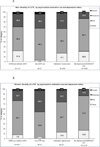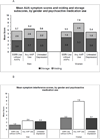Are commonly used psychoactive medications associated with lower urinary tract symptoms?
- PMID: 22138718
- PMCID: PMC3538827
- DOI: 10.1007/s00228-011-1170-9
Are commonly used psychoactive medications associated with lower urinary tract symptoms?
Abstract
Purpose: Lower urinary tract symptoms (LUTS) such as urinary frequency and urgency are bothersome and associated with reduced quality of life. Atypical antipsychotics (AAPs) have been implicated in increasing the risk of urinary incontinence. In a large community-based sample of men and women, we examined the associations of AAP and selective serotonin reuptake inhibitor (SSRIs) use with LUTS.
Methods: Data were collected (2002-2005) from a generalizable sample of Boston, MA, USA, residents aged 30-79 (N = 5503). LUTS were assessed using the American Urologic Association Symptom Index (AUA-SI). The prevalence of clinically-significant LUTS was estimated using a cutoff AUA-SI score of 8+ to indicate moderate-to-severe symptoms. Confounder-adjusted odds ratios (ORs) and 95% confidence intervals (CI) were calculated from multivariate logistic regression to estimate the associations for psychoactive drugs used in the previous month (SSRIs, AAPs, both) and LUTS.
Results: Among women, AAP users had a higher prevalence of LUTS (46.2%) compared with SSRI users (23.5%) and those with depressive symptoms not using SSRIs or AAPs (26.3%). Corresponding prevalence estimates among men were 32.7%, 29.8%, and 33.3%. In multivariate models, AAP use was significantly associated with LUTS among women when used either with (OR = 2.72, 95% CI:1.45-5.10) or without (OR = 3.05, 95% CI:1.30-7.16) SSRIs, but SSRI use without AAP use was not associated with LUTS compared with nonusers without depressive symptoms. No associations were observed among men.
Conclusions: In our study, AAPs but not SSRIs were associated with increased prevalence of LUTS among women only. Further prospective research is needed to determine time sequence and cause and effect.
Conflict of interest statement
Conflict of interest statement
Dr. William Steers reports service to the American Urologic Association as the editor of the Journal of Urology, and is a consultant to New England Research Institutes. All other authors declare no conflicts of interest.
Figures


Similar articles
-
Commonly used antihypertensives and lower urinary tract symptoms: results from the Boston Area Community Health (BACH) Survey.BJU Int. 2012 Jun;109(11):1676-84. doi: 10.1111/j.1464-410X.2011.10593.x. Epub 2011 Sep 27. BJU Int. 2012. PMID: 21951754 Free PMC article.
-
Co-Occurrence of Lower Urinary Tract Symptoms and Frailty among Community-Dwelling Older Men.J Am Geriatr Soc. 2020 Dec;68(12):2805-2813. doi: 10.1111/jgs.16766. Epub 2020 Aug 21. J Am Geriatr Soc. 2020. PMID: 32822081 Free PMC article.
-
Association of C-reactive protein and lower urinary tract symptoms in men and women: results from Boston Area Community Health survey.Urology. 2009 May;73(5):950-7. doi: 10.1016/j.urology.2008.12.012. Urology. 2009. PMID: 19394490 Free PMC article.
-
Global burden and temporal trends of lower urinary tract symptoms: a systematic review and meta-analysis.Prostate Cancer Prostatic Dis. 2023 Jun;26(2):421-428. doi: 10.1038/s41391-022-00610-w. Epub 2022 Nov 21. Prostate Cancer Prostatic Dis. 2023. PMID: 36414786
-
Links between lower urinary tract symptoms, intermittent hypoxia and diabetes: Causes or cures?Respir Physiol Neurobiol. 2018 Oct;256:87-96. doi: 10.1016/j.resp.2017.09.009. Epub 2017 Sep 18. Respir Physiol Neurobiol. 2018. PMID: 28923778 Free PMC article. Review.
Cited by
-
Nurse-Led Medicines' Monitoring for Patients with Dementia in Care Homes: A Pragmatic Cohort Stepped Wedge Cluster Randomised Trial.PLoS One. 2015 Oct 13;10(10):e0140203. doi: 10.1371/journal.pone.0140203. eCollection 2015. PLoS One. 2015. PMID: 26461064 Free PMC article. Clinical Trial.
-
The Problem of Polypharmacy in Female Patients with Overactive Bladders - Cross-Sectional Study in a Specialist Outpatient Department.Geburtshilfe Frauenheilkd. 2016 Dec;76(12):1318-1324. doi: 10.1055/s-0042-114221. Geburtshilfe Frauenheilkd. 2016. PMID: 28042169 Free PMC article.
-
Prevalence of commonly prescribed medications potentially contributing to urinary symptoms in a cohort of older patients seeking care for incontinence.BMC Geriatr. 2013 Jun 10;13:57. doi: 10.1186/1471-2318-13-57. BMC Geriatr. 2013. PMID: 23758756 Free PMC article.
-
The role of prescription drugs in female overactive bladder syndrome-A population-wide cohort study.Pharmacoepidemiol Drug Saf. 2020 Feb;29(2):189-198. doi: 10.1002/pds.4920. Epub 2019 Dec 5. Pharmacoepidemiol Drug Saf. 2020. PMID: 31808271 Free PMC article.
-
Olanzapine as a cause of urinary incontinence: a case report.Iran J Psychiatry. 2012 Summer;7(3):146-8. Iran J Psychiatry. 2012. PMID: 23139697 Free PMC article.
References
-
- Kuehn BM. Questionable antipsychotic prescribing remains common, despite serious risks. Jama. 303(16):1582–1584. - PubMed
-
- Verdoux H, Tournier M, Begaud B. Antipsychotic prescribing trends: a review of pharmaco-epidemiological studies. Acta psychiatrica Scandinavica. 2010;121(1):4–10. - PubMed
-
- Tyrer P, Kendall T. The spurious advance of antipsychotic drug therapy. Lancet. 2009;373(9657):4–5. - PubMed
MeSH terms
Substances
Grants and funding
LinkOut - more resources
Full Text Sources
Medical
Miscellaneous

